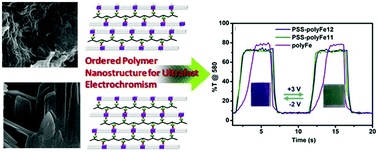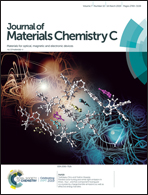Nanostructured metallo-supramolecular polymer-based gel-type electrochromic devices with ultrafast switching time and high colouration efficiency†
Abstract
Electrochromism is a commercially demanding display technology most commonly used in smart windows, information displays etc. Herein, a purple coloured Fe(II)-containing metallo-supramolecular polymer (polyFe) is synthesized and subsequently combined with sodium polystyrene sulfonate (PSS) to provide three polymer composites (PSS–polyFe12, PSS–polyFe11, and PSS–polyFe21) by controlled counter-anion exchange at different molar ratios. The optical investigations confirm the interaction of PSS with polyFe, while the structural characterizations demonstrate the long-range ordering in PSS–polyFe composites and intercalation of PSS polymer chains in between two succeeding polyFe chains by electrostatic interactions. Field-emission electron microscopy shows three tunable distinct morphologies which vary from a low aspect ratio nanorod in PSS–polyFe12 to a high aspect ratio flat 2D layer nanoplate in PSS–polyFe21 via an interconnected nanofiber in PSS–polyFe11. The cyclic voltammetry study confirms the diffusion controlled redox system in the composite and counter-anion diffusion is enhanced with enhanced PSS concentration in the composites. Gel-type electrochromic devices show the colour change from pristine purple to transparent pale green under a controlled potential switching from −2 V to +3 V. Gel-type electrochromic devices reveal more stable electrochromic performance (ΔT remains the same even after 3000 s) along with a decrease in the oxidation potential (2.42 V → 2.12 V) in PSS–polyFe11 compared to that of pristine polyFe. The electrochromic switching times are improved by 68.5% for bleaching (2.96 s → 0.93 s) and 30.7% for colouring (0.65 s → 0.45 s) in PSS–polyFe11 compared to that of pristine polyFe due to the swift anion diffusion and higher ionic conductivity in the composite structures in intercalated PSS chains. The colouration efficiency is also improved by 66% (250.21 → 414.18 cm2 C−1) in the PSS–polyFe11 containing device compared to that in pristine polyFe. Therefore, the present work will be beneficial for providing a simple viable strategy for enhancing the electrochromic parameters in an electrochromic polymer by ordered binary composite formation.



 Please wait while we load your content...
Please wait while we load your content...